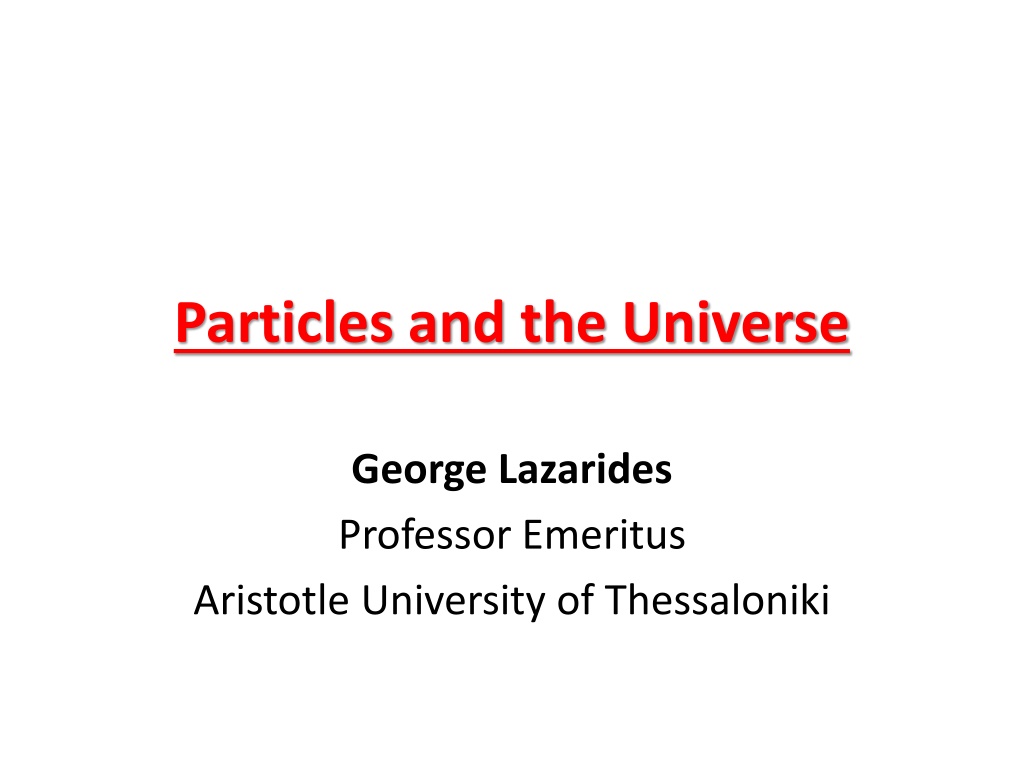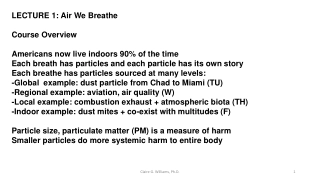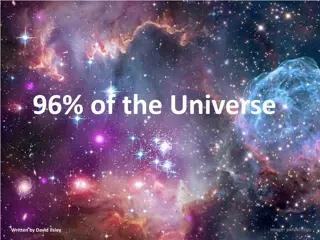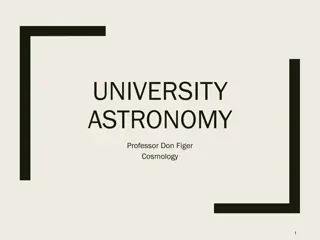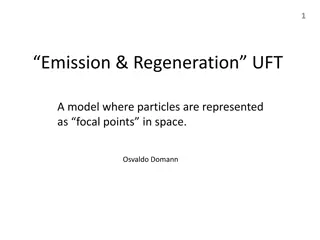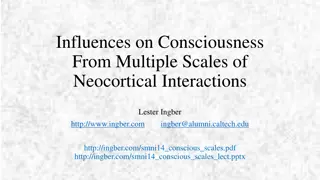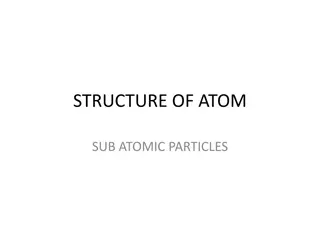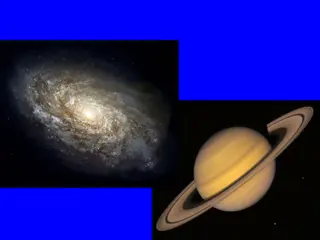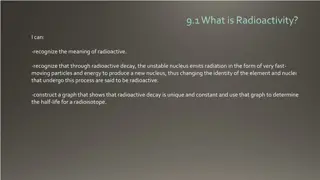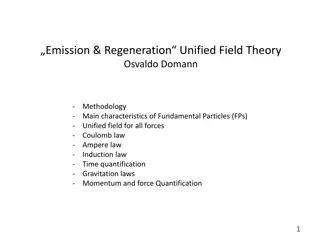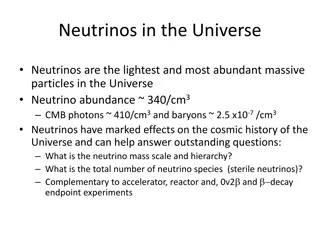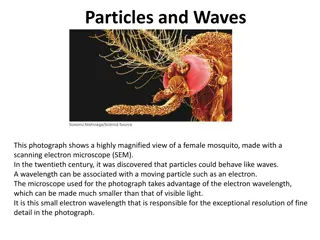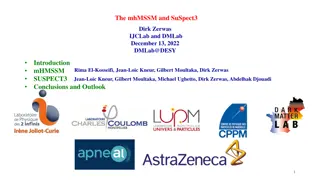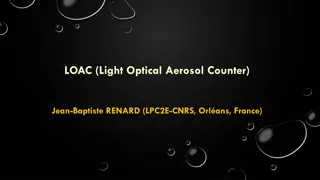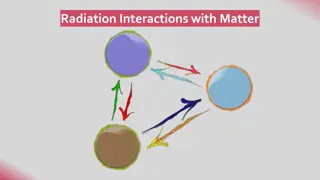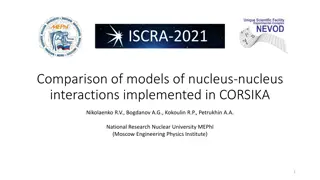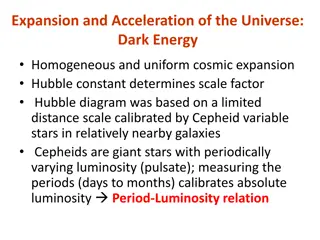Exploring Particles and Fundamental Interactions in the Universe
Delve into the intricate world of particles and fundamental interactions in the Universe as explained by Professor Emeritus George Lazarides from Aristotle University of Thessaloniki. Discover the structure of matter, classification of particles based on interactions, constituents of hadrons, conservation laws, and the concept of symmetries in relation to conservation quantities. Explore the implications of promoting U(1)EM to a local gauge field and the role of gauge fields in electromagnetic interactions.
Download Presentation

Please find below an Image/Link to download the presentation.
The content on the website is provided AS IS for your information and personal use only. It may not be sold, licensed, or shared on other websites without obtaining consent from the author. Download presentation by click this link. If you encounter any issues during the download, it is possible that the publisher has removed the file from their server.
E N D
Presentation Transcript
Particles and the Universe George Lazarides Professor Emeritus Aristotle University of Thessaloniki
Structure of matter and fundamental interactions Macroscopic matter Molecules Atoms Electrons + nucleons e n,p + plethora of elementary particles However, there is a small number of really elementary particles which construct all other particles The components of matter interact with four fundamental interactions
The fundamental interactions (i) Strong nuclear 1 Nuclear and subnuclear phenomena Microscopic range (ii) Electromagnetic 10-2 (iii) Weak nuclear 10-5 n p e- ?e Macrocosmos Infinite range (iv) Gravitational 10-38
Classification of particles Particles are classified according to participation in strong interactions: ?? ? ?? ? ?? ? Q = 0 anti- particles Leptons + Q = -1 Particles Baryons: p, n, (fermions) Hadrons Mesons: 0, , (bosons) Particle reactions: a b c d Conservation laws: Energy, momentum, angular momentum, electric charge e- stability Baryon number p stability e- lepton number - lepton number - lepton number Non absolute
The constituents of hadrons Hadrons consist of quarks ? ? ? ? ? ? Q = 2/3 anti- particles + flavors Q = -1/3 Each quark three colors : u u1 u2 u3 Color confinement: 1 1 Mesons Baryons 2 1 3 0 = u1 1+ p = u1 u2 d3
Conservation laws Symmetries Group of transformations leaving the dynamics invariant : ?,? ? (Lie group) ?? ? (manifold) ? ?: ? ???,???, = ? ??,??, The generators of such a group Conserved quantities (The generators span the Lie Algebra, i.e. the tangent space at the identity element of ?) Conservation of electric charge, baryon number, e- lepton number, ??? ? ? symmetries U 1 = circle (one dim manifold) One generator y Lie Algebra (one dim) x
If we promote U(1)EM to local (gauge) A gauge field A (photon), carrier of electromagnetic interactions. ??= ? infinite range of interactions The other U(1) s (baryon, lepton numbers) remain global they do not imply any interaction , only conservation laws (may not be absolute).
Electroweak theory (Weinberg, Salam, Glashow 1967) A gauge theory with Group SU(2)L U(1)Y U(1)EM (SU(2)L U (2x2 matrices) with U U = 1, detU = 1 and act on the (L-handed) quark/lepton doublets. As a manifold is a 3 dim sphere in 4 dims.) Four generators Four gauge fields 82GeV 92GeV W+ W- Z0 (CERN, Rubbia 1984) photons Carriers of weak interactions W , Z0 acquire masses from the spontaneous breaking SU(2)L U(1)Y? 0U(1)EM(? = Higgs field) microscopic range of Weak interactions . The associated Higgs Boson discovered in 2012 at CERN with mH 125 GeV
Strong Interactions Gauge theory with Group SU(3)c U (3x3 matrices) with U U = 1, detU = 1 acting on the three colors Quantum Chromodynamics (QCD) SU(3)C is 8 dim Eight Gauge bosons (Gluons), the carriers of Strong Interactions. SU(3)Cis unbroken Gluons are of zero mass, but Strong Interactions are of microscopic range because of Confinement of color: The asymptotic states are colorless QCD Asymptotic freedom (force gets weaker at smaller distances ) Gross/Politzer/Wilczek (Nobel Prize 2004)
Supersymmetric Standard Model Putting everything together Standard Model with G = SU(3)C SU(2)L U(1)Y Imposing Supersymmetry which doubles the particles (a boson for each fermion and a fermion for each boson) Supersymmetric Standard Model
Unification of the 3 interactions The Unification requires Supersymmetry if we assume A great desert . So we can assume that at Unification a larger gauge group emerges (the smallest possible is SU(5)) < 5> < 24> SU(5) SU(3)C SU(2)L U(1)Y SU(3)C U(1)EM X~1016GeV W~100GeV
Existence of 12 more gauge fields (X, Y) with mX,Y ~ 1016GeV violate Baryon number Proton decay p e+ + 0, for example Super-Kamiokande Lower bound on proton lifetime ~ 1034 years GUT is consistent with s ?3 2 4? 0.1184 and sin2 W ?2 2 0.23116 ?2 It explains the quantization of electric charge and predicts the existence of Magnetic monopoles . It can provide small masses to neutrinos and thus explain oscillations . In some cases, it predicts Cosmic Strings, domain walls,
Microcosmology Is the study of the initial stages of universe evolution in accordance with particle physics SBB cosmology The universe began 13.8 109 years ago with a BIG BANG . It was concentrated within an infinitesimal volume with infinite T and space-time emerged together with matter. After Big Bang and for t tPl = 10-43 sec, quantum fluctuations of gravity ceased Classical Gravity (The general relativity theory) + GUTs for the other 3 interactions (quantum + relativistic)
Phase transitions of the universe As the universe expanded and cooled after the BIG BANG, it underwent a series of phase transitions T~ 100 GeV X,Y become massive T~ 1016 GeV ?~ 10-10 s ?~ 10-37 s SU(5) SU(3)C SU(2)L U(1)Y > creation of Baryon Asymmetry (violation of Baryon number C, CP, lack of thermal equilibrium) (ii) creation of Magnetic Monopoles (i) initial light soup of massless quarks, leptons, X, Y, T~ 1 GeV T~ 1 MeV ?~ 10-4 s ?~ 180 s SU(3)c U(1)EM nucleosynthesis (successful prediction of abundances of H, D, 3He, 4He, 7Li) Confinement (quarks hadrons)
?~ 300 000 yr ?~ 3000 yr ?~ 200 000 000 yr Matter domination Decoupling of matter and radiation structure formation (galaxies, filaments, great voids, ) (i) Creation of atoms (ii) Creation of Cosmic Microwave Background Radiation (CMBR) of 2.7 K, echo of initial light (1964) 50 Million Iight yrs
Successes of BIG BANG cosmology + GUTs (i) Expansion of the Universe (Hubble s law) (ii) Generation of BAU (excess of baryons over antibaryons) by the X,Y decay at GUT transition (iii) Successful Nucleosynthesis (iv) CMBR
Shortcomings i. Magnetic Monopole Problem : During GUT transition Magnetic Monopoles = topologically stable localized deviations from vacuum with radius ~ MX too large at Nucleosynthesis destroying its successful predictions. -1, energy MX/ Gand net magnetic charge. Their density is ii. Planck measurements on CMBR + other observations Present universe is flat (of zero 3-dim curvature) within 1% ( = / C = 1 0.01). So following the evolution backwards in time It must have started being flat to a great accuracy . Question: How come the universe started flat to many many decimals, although it could have any curvature positive or negative? (Flatness problem)
Shortcomings iii. Horizon Problem : CMBR emitted at t 300 000 yr from the last scattering surface at a distance 13.8 109 light yr. COBE/WMAP/Planck The T of CMBR is the same from all directions with accuracy / = 6 10-6 Regions that emitted CMBR had no time to communicate causally after the BIG BANG (t = 0) before emitting radiation. How come thermodynamic equilibrium was established? last scattering surface
Cosmological Inflation a period of exponential expansion Solves all three puzzles in one go = Inflaton (a Higgs field connected with GUT breaking)
Due to quantum tunneling A bubble is created with 0, V 0, almost constant. The bubble expands exponentially fast and covers our universe several times.
Inflation automatically solves all puzzles i. Magnetic Monopoles are diluted so that they do not cause any problem. ii. Exponential expansion can bring to zero any preexisting curvature iii. It can also establish causal communication between regions of the last scattering surface
On the top of these, it transforms the quantum fluctuations of the inflaton into classical metric perturbations Density perturbations / 5.6 10-5 (primordial) (a) Grow in the late universe to become non-linear Formation of structure (galaxies, ) via gravitational collapse of matter. (b) Generate the temperature fluctuation / 6 10-6 in the CMBR measured by COBE/WMAP/Planck. The predictions of inflation can fully agree with all experiments!
Planck 2018 results -300 300
Dark Energy Inflation: (i) present universe is exactly flat ( = / C = 1) and thus will keep expanding for ever. (ii) Matter is only 27% of the universe Question: What is the rest 73% made of? In 1997-8, observations on Supernovae Ia (which we see now as they were in previous time) The expansion then was slower than it is today The expansion of the universe is accelerating ! This can be explained if more than 2/3 of the energy in the universe is in the form of Cosmological Constant , i.e. it is not diluted by the expansion (negative pressure) exactly as in inflation . Question: Are we about to enter a new Inflationary phase? WMAP/Planck confirm that 73% of the energy density in the universe in the form of Dark Energy , i.e. something close to a Cosmological Constant.
Dark Matter Study of Nucleosynthesis + Planck result Baryonic (visible) Matter is only 4.84%. So, about 27% - 5% 22% of the universe is DARK MATTER . Question: What is the nature of Dark Matter? It was shown that Dark Matter should be mainly cold , i.e. consisting of particles with m 0 which have small velocities and interact with the other particles only gravitationally . What could the Dark Matter particles be? (i) LSP = the lightest supersymmetric particle This is protected by R-parity symmetry from decaying remains in the universe for ever (many calculations of its relic density have been performed) (ii) Axions (connected with the problem of CP violation in Strong Interactions (iii) Can we detect Dark Matter? The LSPs can be detected by their scattering by protons Many experiments in progress No positive results so far Detection of Axions is even harder.
Quantum Gravity So far, we considered Gravity at the classical (non-quantum) level and separately from the other 3 interactions which are described by relativistic Quantum Field Theory and possibly unified in a GUT. Questions: (a) Can gravity be quantized as the other interactions? (b) Can be unified with the other 3 interactions a Theory of everything ? Quantum Gravity phenomena are expected to appear at very high energies ~mPl = 2.44x1018 GeV or small distances ~?Pl~ 10-33 cm or small times ~ tPl~10-43 s (???= ? 1/2/ 8? , ?: Newton s constant) (i) So, quantum fluctuations of Gravity play a role very near the BIG BANG for t tPl ??? (ii) Also, possible primordial Gravity waves could originate from the quantum fluctuations of Gravity during Cosmological Inflation (May be detected in the future) 1
Renormalizability In trying to construct a Quantum Field Theory for Gravity we encounter problems with Renormalizability . To understand the meaning of Renormalizability , let us take as example Classical Electrodynamics : Energy of the E field ??4 r dr = 4 ?? ? ?? ?? ? Relativity Every elementary particle is point like Energy of its E field is infinite We must then assume that its bare mass is - the final mass = - is finite. The situation appears also in Quantum Electrodynamics where we encounter several meaningless infinities in calculating various processes.
However, all these infinities can be systematically gathered and put inside two parameters (the mass and charge of electron). We then take the bare parameters infinite , so that their final Renormalized values are finite = their experimental values. This complicated mathematical procedure is called Renormalization and the theories where it applies are called Renormalizable . The 3 interactions (except Gravity) are Renormalizable ( T Hooft/Veltman) With a finite number of experiments we determine the values of a finite number of parameters. Everything else can be predicted Predictability The problem with Quantum Gravity is that it is not Renormalizable .
String Theory The theory of (super) strings was proposed to cure this difficulty and also unify Gravity with the other interactions Theory of Everything . The idea is that the fundamental objects are not point like particles but one dimensional strings . Adding Supersymmetry Superstrings . So, we have strings of size ~ ???~10 33 cm which vibrate, but for the present energies look like point particles . The various vibrational modes of strings appear as particles with different charges . So, there is a unified description of all particles and their interactions .
The abandonment of point particles removes infinities. It is believed that String Theory finite results. One of the vibrational modes is the graviton (carrier of gravitational interactions). So, we can in principle describe Quantum Gravity and the other 3 interactions in a unified way The theory of everything . However, there are some important shortcomings of String theory . (i) Initially, we thought A unique solution of String theory Very high predictability . However, we now know A huge number of solutions (~10500) Landscape with a huge number of hills, valleys A huge number of minima . Anthropic principle : The minimum (solution) corresponding to our Universe had the right conditions so as to produce Us eventually. (ii) Although there exist very many solutions None of them reproduces exactly our Universe.
Predictions of String Theory Six of them are compactified , i.e. they are strongly curved to form a 6 dimensional compact manifold of size ~???~10 33 cm. There exist 10 dimensions (or 11 in the case of M theory). spacetime . The other 4 dimensions remain open and correspond to the usual The geometric structure of the compactified dimensions determines many of the phenomena in spacetime .
Strings allow us to discuss Quantum Gravity Gives us the possibility to approach BIG BANG ( initial singularity at t = 0) for t ???~10 43 s or consider t < 0 too (before BIG BANG). One problem we can now address is the problem of initial conditions for Inflation. Inflation takes place at t ~10 37 s ??? , where we need a large homogenized region as initial condition for Inflation to start. However, this region consists of many regions of smaller size ~? , which had no time to communicate causally so as to become homogenized at the onset of Inflation. This is again a problem of initial conditions . So we need a first stage of Inflation near or before BIG BANG to provide the necessary homogenization required for conventional Inflation.
One possible solution pre BIG BANG scenario. Imagine that we travel backwards in time and pass through the initial singularity at t = 0 , which is though smoothed by strings and enter the realm of negative times ( before BIG BANG). There, during the motion of the Universe towards the initial singularity , we have conditions of very high curvature and the extra dimensions contract and compactify Inflation (accelerated expansion) in the 4 open dimensions. This can be the 1st stage of Inflation Initial conditions for the conventional Inflation or can be the main Inflation producing the density perturbations too. We should be very careful with these considerations since the physics of strings is not fully understood or solved yet.
Another application of Quantum Gravity could be the explanation of the origin of primordial gravity waves if such waves are detected. BICEP2 Observed the polarization of CMBR Contains not only ? mode but ? mode too. Subtracting the ? mode from polarized dust there is a remaining ? mode which could be due to primordial gravity waves from Inflation.
Planck did not confirm this conclusion of BICEP, which underestimated the foreground from polarized dust. However, possible existence of primordial gravity waves which may be measurable in the foreseeable future cannot be excluded. These waves could originate from tensor (gravitational) quantum fluctuations during Inflation which become Classical fluctuation (i.e. gravity waves) as they exit the Inflationary horizon So Quantum Gravity is required to understand these waves.
